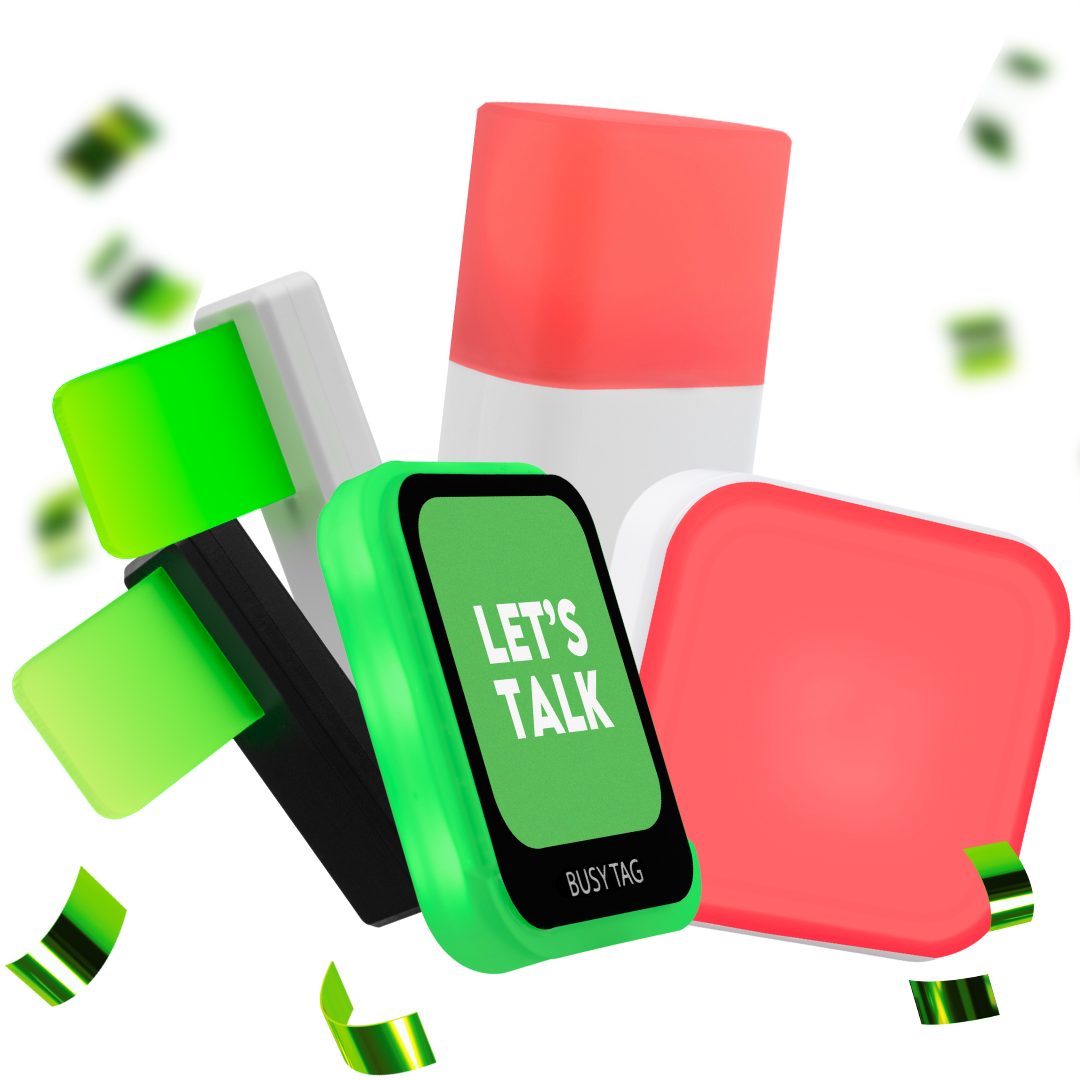3 Brand new productivity tools
Step up your productivity game with the sleek new additions to our lineup.
2nd gen USB busy light availability indicator with an updated design and USB-C support
Standalone busy light for offices. Works for meeting rooms just as well as for desk workstations.
App-free, wireless & remote-controlled busy light for offices and meeting rooms.
Browse our classics
Here you can find a range of products designed to improve workplace productivity through visual indicators, interactive buttons, LED-based solutions, air quality sensors and more. Designed and made by Luxafor.
LED busy light that eliminates workspace distractions.
2nd Gen wireless & remote-controlled conference or patient room indicator with 4 color modes. No software needed.
2nd Gen wireless & software-controlled LED busy light indicator improving productivity and structurizing workflow.
Wide-angle USB LED busy light that eliminates distractions
A 262K 240×280 color screen with a built-in busy light patterns, GIFs, videos playback, image statuses and more to empower your creativity and success.
Wireless & software-controlled LED do not disturb light that helps managing notifications and personal availability.
Wireless & remote-controlled availability indicator that displays meeting room and workstation availability in real-time.
Standalone LED and do not disturb light that displays meeting room availability.
USB-powered LED display timer that helps break down work in bite-sized chunks.
Switch the mic on/off with a simple touch to show if you are available with red/green.
Analyzes Air Quality Of A Room And Notifies You When It Requires Ventilation
Notifies you when room requires fresh air, allowing you to lower CO2 levels
Luxafor Smart Button is an interactive productivity gadget for customizing and optimizing workflow processes.
Wireless headphones with active noise cancelling technology.
LED availability indicator that eliminates workspace distractions.
2nd Gen wireless remote-controlled patient room, workplace or conference room indicator with 4 color modes. No software needed.
2nd Gen wireless & software-controlled LED busy light indicator improving productivity and structuring workflow.
wide-angle USB LED availability indicator that eliminates distractions
A 262K 240×280 color screen with a built-in busy light patterns, GIFs, videos playback, image statuses and more to empower your creativity and success.
Wireless & software-controlled LED availability indicator that displays notifications and personal availability.
Wireless & remote-controlled availability indicator that displays meeting room and workstation availability in real-time.
Standalone LED availability indicator that displays meeting room availability.
USB-powered LED display timer that helps break down work in bite-sized chunks.
Switch the mic on/off with a simple touch to show if you are available with red/green.
Monochrome USB LED availability/ busy light that eliminates distractions and boosts productivity.
LED availability indicator that eliminates workspace distractions.
Request a Quote
Interested in ordering Luxafor accessories in bulk?
Send us a message and we'll prepare a quote for you!
Choose your productivity solution
Luxafor products provide tailor-made workplace solutions by combining visual indicators (known as busy lights or do not disturb lights) with technology to enhance productivity, concentration, and communication in the modern workspace. Their ability to cater to individual preferences and seamlessly integrate with existing software tools makes them a valuable addition to any professional's toolkit.
Luxafor Flag displays your availability and ensures you only get visual notification cues on what’s important to you.
- USB connection
- Software controlled (Win, Mac)
- Plenty of presets & unlimited custom colors
- Custom workflows with most popular services
- With red and green, show everyone if you're busy or free;
- Optimize your work process control to attain focused work;
- Choose from various services to manage your productivity and workflow at the speed of light;
- Get simple installation and functioning on Windows, Mac, and Android
Luxafor Smart Button offers an incredible chance to enhance task execution efficiency and optimize workflow processes.
- Trigger both hardware and software events
- Software controlled (Win, Mac)
- Create and modify your own tap-based patterns
- Customize your workflow with most popular services
Luxafor ANC Headphones help you eliminate the number one workplace distraction – noise – to deliver exceptional results.
- Compact and lightweight wireless design
- Use with or without Active noise cancelling
- Comfortable and soft ergonomic ear-cups
- Rechargeable battery
Luxafor Bluetooth Shows workspace availability and notifications in real- time within 25 meters distance.
- Bluetooth connection via LED dongle
- Software controlled (Win, Mac, Android)
- Plenty of presets & unlimited custom colors
- Custom workflows with most popular services
Luxafor Switch shows workspace and meeting room availability in real- time within 25 meters distance from the remote unit.
- Truly wireless connection
- No software needed
- 4 color options
- Rechargeable battery
Luxafor Cube allows to show workspace and meeting room availability in real-time with four colors.
- No software needed
- Simply rotate sideways to change colors
- 4 default color options
- Long battery life
A must-have custom LED timer for Pomodoro technique that is easy to set up and simple to use.
- Use preset time intervals or define your own
- Discreet vibrating alerts without music
- Custom colors and patterns
- Adjust the LED brightness
- USB powered
Luxafor CO2 Monitor is a device that tracks carbon dioxide levels (CO2) in indoor spaces, ensuring safe air quality and timely ventilation notifications.
- Convenient visual aid to help you monitor air quality;
- Visual & sound alerts reminding you to ventilate the room;
- CO2 level measurement with a refreshment rate of few minutes;
- Temperature & humidity measurements;
- Battery powered
A must-have custom LED timer for Pomodoro technique that is easy to set up and simple to use.
- Mute/unmute your microphone with a touch of a button while you're busy in a conference call;
- Show everyone your microphone is muted/unmuted with red and green;
- Works with ALL tools by muting mic computer-wide;
- Use custom color coded signals to show if you're busy or available while working from home;
- USB powered
Luxafor Orb is a visual status indicator device used to display one’s availability or work status, enhancing workplace communication.
- Tell your colleagues you're busy or free with red and green;
- Boost your performance by controlling your workflow;
- Connect to hundreds of popular services to get your workflow and communication under greater control;
- Customize functionality - use pre-built features or create your own via our API;
- Enjoy easy set up process on both Windows and Mac.
A must-have custom LED timer for Pomodoro technique that is easy to set up and simple to use.
- Tell everyone you're busy with the light on (Stop Sign) or Free with the light off;
- Improve your workflow to achieve deep work.
- Synchronize with many popular services to get your workflow and work environment under control;
- Adapt the functionality to meet your individual requirements - apply pre-built functions or make your own using our API.
It’s a portable device that measures carbon dioxide (CO2) levels in the air, along with temperature and humidity and being widely used for monitoring indoor air quality.
- Smart aid to help you monitor air quality on the go.
- Visual & sound alerts to ventilate your living room, bedroom or office.
- Air Quality detection at a refresh rate of 3/5/10 minutes.
- Regular monitoring of carbon dioxide (CO2), temperature (C° / F°) and humidity to keep the optimal living and working standards.
- Controlled via Android/ iOS app.
What Our Customers Say



Change Your Worklife. Start now.
Join more than 214 307 high achievers!













